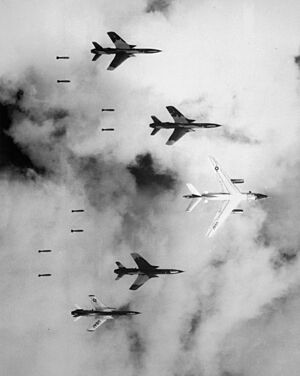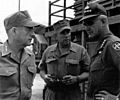Role of the United States in the Vietnam War facts for kids
The United States' involvement in the Vietnam War was a big part of its history. It started after World War II and grew into a full commitment during the Vietnam War, which lasted from 1955 to 1973. The U.S. got involved in South Vietnam because of many years of political and economic actions. These actions aimed to stop the spread of communism in Vietnam.
At first, the U.S. supported French forces who were fighting in Vietnam. President Harry S. Truman sent more and more money and military help to the French. By 1950, the U.S. was not just helping the French. They also started giving direct military aid to Vietnam, Laos, and Cambodia. The U.S. wanted to stop communism from taking over the government in Vietnam. They worried that if Vietnam became communist, other nearby countries would too. This could change the balance of power in Southeast Asia. The U.S. government believed this communist spread was a threat to its national security. They tried hard to stop it. However, many people in the government and society, including the U.S. Congress, started to question these actions.
The war caused a lot of deaths. Between 966,000 and 3,812,000 Vietnamese soldiers and civilians died. Also, 58,318 U.S. soldiers lost their lives.
Contents
Why the U.S. Got Involved
The United States became deeply involved in Vietnam for several key reasons. These reasons were mostly about stopping the spread of communism. This idea was a major part of U.S. foreign policy during the Cold War.
Stopping Communism's Spread
The main reason for U.S. involvement was the fear of communism. Leaders in the U.S. believed in something called the "domino theory." This theory suggested that if one country in Southeast Asia fell to communism, then neighboring countries would quickly follow, like a row of dominoes. They worried that if Vietnam became fully communist, it would lead to communism spreading across all of Southeast Asia. This would threaten U.S. interests and allies in the region.
Supporting Allies and Preventing Takeovers
The U.S. also wanted to support its allies. France was a key ally, and they had a long history in Vietnam. When France struggled, the U.S. stepped in to help. This was part of a larger effort to prevent communist takeovers around the world. The U.S. saw itself as a protector against communist expansion. They believed that helping South Vietnam resist communism was important for global stability.
Protecting National Security
U.S. leaders felt that the rise of communism in Vietnam could affect their own country's safety. They believed that a change in the balance of power in Asia could lead to bigger problems. So, they saw their actions in Vietnam as a way to protect U.S. national security. This meant using both money and military power to try and stop the spread of communism.
U.S. Military Actions and Escalation
The U.S. started by sending money and supplies. But over time, their involvement grew much larger. This increase in military help is known as escalation.
Early Assistance to French Forces
From 1950, President Harry S. Truman began sending aid to French forces. They were fighting against Vietnamese nationalists, many of whom were communists. This aid included money, weapons, and military advice. The goal was to help France keep control and prevent a communist victory.
Direct Military Involvement Begins
After France left Vietnam, the U.S. started to give direct military help to South Vietnam. This was to support the non-communist government there. More U.S. military advisors were sent to train the South Vietnamese army. Over the years, the number of U.S. troops increased. Eventually, U.S. soldiers were directly involved in fighting. This marked a major shift from just providing aid to full military commitment.
Major Military Operations
U.S. forces carried out many military operations. These included bombing campaigns and ground battles. The aim was to weaken the communist forces in North Vietnam and South Vietnam. However, the war became very difficult. The U.S. faced a determined enemy and challenging jungle terrain. The conflict lasted for many years, from 1955 to 1973.
Impact and Consequences
The Vietnam War had huge impacts on both Vietnam and the United States. It was a long and costly conflict.
Human Cost of the War
The war resulted in a tragic loss of life. Millions of Vietnamese soldiers and civilians died. The exact number is hard to know, but it was very high. For the United States, over 58,000 soldiers were killed. Many more were injured or went missing. The war also caused lasting physical and mental health problems for many veterans.
Effects on U.S. Society
The war deeply divided American society. Many people supported the war, believing it was necessary to stop communism. However, a large number of people protested against it. They questioned why the U.S. was involved and the high cost in lives and money. These protests led to major social and political changes in the U.S. The war also led to a lot of debate within the U.S. government.
Long-Term Changes
The Vietnam War changed how the U.S. approached foreign policy. It made leaders more careful about sending troops to other countries. The war also showed the limits of military power. It taught important lessons about understanding local cultures and political situations. The conflict left a lasting mark on the history of both Vietnam and the United States.
Images for kids








